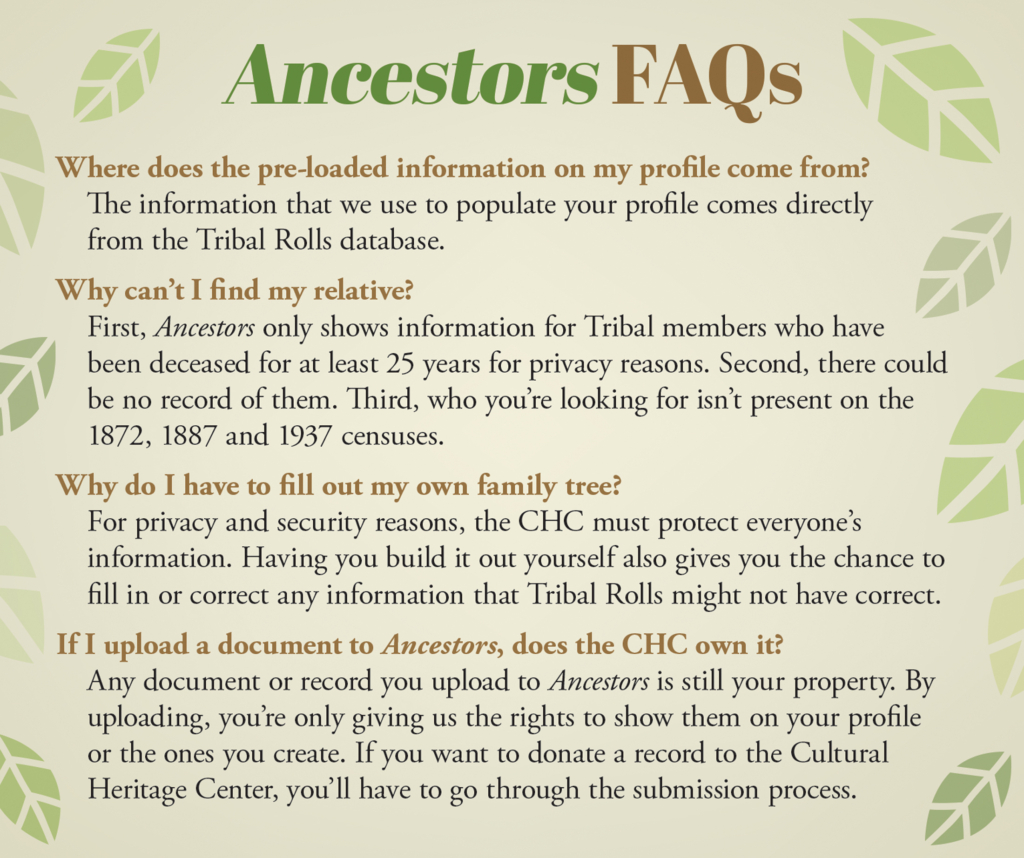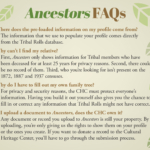Ancestors, a platform to research family history, allows Tribal members to learn about and share information on their ancestral family. Staff from the Cultural Heritage Center and Information Technology departments developed the platform, including CHC Director Dr. Kelli Mosteller.
“We wanted to create a platform that gave our Tribal members an opportunity to easily access the fruits of that archival labor,” she said. “It is still a relatively new platform, so we are still updating it, working through bugs, and finding ways to add more information about our ancestors for those who want to do family research.”
Dennis Johnson began working on his family history 25 years ago. A descendant of the Clardy and Bertrand families, he always looks for new ways to learn something about his Potawatomi ancestry on his maternal side. In a recent interview, he told the Hownikan he approaches genealogy as a “hunter-gatherer.”
“I tend to focus on my direct lines and research lines on family branches where there’s interest. Research is by databases, family records and on-site research,” he said.
Ancestors’ search function allows users to simply type in their family’s name to start looking at records. Johnson enjoys maps, official documents, newspaper articles and more to help tell his families’ stories. The new site offered him access to specific pieces of information he had not seen in more than two decades of building family trees. Dr. Mosteller and the staff purposefully made it accessible and user friendly for those deep in their family history and others casually browsing.
“We have tried to find a balance between those Tribal members who just want to learn more about their family members, without having to do a lot of further research, and those who are using Ancestors as a tool to do much deeper and more extensive research about their family or the Tribe,” she said. “To that end, we have linked each individual back to the larger collection of archival documents associated with their family. This allows the researcher to explore what we have available in the archives and follow any leads or questions that interest them.”
While looking through the “Family Manuscripts” section of his family’s records, Johnson found something interesting about his relative Joshua E. Clardy, born in 1835, who took an allotment in Indian Territory after the Treaty of 1861. He was issued the first land certificate from the federal government.

“We know that they got a land allotment — number eight — and we can see that in the roll books and all that sort of stuff. But it came up as CT001, and I thought, ‘Oh, wait a minute.’ And then I thought back, ‘Oh, that’s because they took the allotments, obviously, and then they forgot to tell people that they had to prove it.’ And then they had to pay the fee and get their certificate. Well, he was the first one to sign a certificate, so that’s where CT001 is,” Johnson explained.
Thinking back to what he already knew about Joshua Clardy, Johnson realized it made sense that he efficiently settled anything with his land and legal obligations.
“Of course, he ended up at the top of a roll list when it came time for allotment. Well, obviously, he did. He was an attorney. He knew where to be when. And so, he was over at St. Marys (Kansas) and signed up for number eight,” he said.
Ancestors also features a space for each Tribal member to build their profile with facts, significant life events and family trees. To keep information of living members private, web developers created a safe way to interact with other Citizen Potawatomi by sending friend requests via email. After approval, the profiles and a chat function open up to both users.
Johnson believes the best way to build and learn genealogy starts with working together.
“Well, you can’t focus on everything all at once. You just can’t do it. And (you’ve) got to find partners in crime in this hunt. You got to go back and forth and say, ‘Oh yeah, you don’t know what you’re talking about. Go look here at this,’” he said.
Johnson encourages those just getting started to look at Ancestors’ available information. Passing along family stories keeps Potawatomi history alive, and the digitization of records makes it more accessible and easier than ever before.
“Never stop questioning and never stop researching. Keep peeling the onion, peeling the onion. Go where you can. Find what you can, and try and get it to balance. … The stories that are there are part of the stories of you as an individual and your family. It’s your heritage, and you should be proud of it,” Johnson said.
Dr. Mosteller hopes more Tribal members log in to their profiles and provide comments and suggestions.
“In the last year, we hosted several live online tutorials to show Tribal members how to use it for research and how to build out their profiles. We’ve had great feedback from those sessions and continue to see the number of users grow,” she said.
Access Ancestors through the Potawatomi web portal at portal.potawatomi.org. Watch an introduction video about the platform at cpn.news/researchwebinar.

